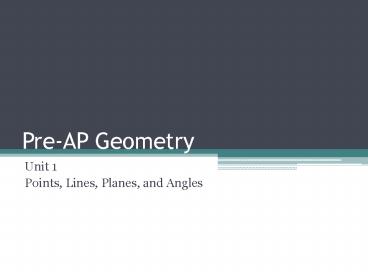PreAP Geometry - PowerPoint PPT Presentation
1 / 19
Title:
PreAP Geometry
Description:
1.1.3 Draw representations of points and lines. 1.2.1 Use the undefined terms point, line, and plane. ... 1.2.3 Use the terms collinear, coplanar, and intersection. ... – PowerPoint PPT presentation
Number of Views:172
Avg rating:3.0/5.0
Title: PreAP Geometry
1
Pre-AP Geometry
- Unit 1
- Points, Lines, Planes, and Angles
2
Objectives
- 1.1 .1 Use the term equidistant.
- 1.1.2 Use the terms point and line.
- 1.1.3 Draw representations of points and lines.
- 1.2.1 Use the undefined terms point, line, and
plane. - 1.2.2 Draw representations of points, lines, and
planes. - 1.2.3 Use the terms collinear, coplanar, and
intersection. - 1.3.1 Use symbols for lines, segments, rays, and
distances. - 1.3.2 Find distances.
- 1.3.3 State and use the Ruler Postulate and the
Segment Addition Postulate. - 1.4.1 Name angles and find their measure.
- 1.4.2 State and use the Angle Addition Postulate.
- 1.4.3 Recognize what can be concluded from a
diagram. - 1.5.1 Use postulates and theorems relating
points, lines, and planes.
3
About AP
- AP can change your life. Through college-level
AP courses, you enter a universe of knowledge
that might otherwise remain unexplored in high
school. - Through AP Exams, you have the opportunity to
earn credit or advanced standing at most of the
nation's colleges and universities.
http//www.collegeboard.com/student/index.html?stu
dent
4
Why Participate
- With 37 courses and exams across 22 subject
areas, AP offers something for everyone. - The only requirements are a strong curiosity
about the subject you plan to study and the
willingness to work hard.
5
Gain the Edge in College Preparation
- Get a head start on college-level work.
- Improve your writing skills and sharpen your
problem-solving techniques. - Develop the study habits necessary for tackling
rigorous course work.
6
Stand Out in the College Admissions Process
- Demonstrate your maturity and readiness for
college. - Show your willingness to push yourself to the
limit. - Emphasize your commitment to academic excellence.
7
Broaden Your Intellectual Horizons
- Explore the world from a variety of perspectives,
most importantly your own. - Study subjects in greater depth and detail.
- Assume the responsibility of reasoning,
analyzing, and understanding for yourself.
8
Introduction to Geometry
Geometry (Greek ?e?µet??a geo earth, metria
measure) is a part of mathematics concerned with
questions of size, shape, and relative
position of figures and with properties of space.
Geometry is one of the oldest sciences.
9
Introduction to Geometry
- Geometry is a type of math used to measure
things that are impossible to measure with
devices. - For example, no one has been able take a tape
measure around the earth, yet we are pretty
confident that the circumference of the planet at
the equator is 24,901.473 miles. - The first known case of calculating the
distance around the earth was done by
Eratosthenes around 240 BC.
10
Introduction to Geometry
- The study of Geometry includes proofs.
- Proofs are not unique to Geometry. They could
have been done in Algebra or delayed until
Calculus. - The reason that high school geometry almost
always spends a lot of time with proofs is that
the first great Geometry textbook, - "The Elements," was written exclusively with
proofs.
11
Introduction to Geometry
- This course, for the most part, is based on
Euclidean geometry. - "Euclidean" (or "elementary") refers to the book
"The Elements" written over 2,000 years ago by a
man named Euclid.
12
Introduction to Geometry
- Euclid started with some basic concepts.
- He built upon those concepts to create more and
more concepts. - His structure and method influence the way that
geometry is taught today.
13
Introduction to Geometry
- This course will include more than just facts
about geometric objects the ability to "prove"
that a particular answer is correct using logic
and reason is the most important part of this
course.
14
Basic Figures
- Point
- A point is a geometric element that has position
but no dimensions and is used to define an exact
location in space. - A point has no volume, area, or length, making it
a zero dimensional object. - A point is defined by its coordinates.
15
Basic Figures
- Line
- A line can be described as an ideal zero-width,
infinitely long, perfectly straight curve (the
term curve in mathematics includes "straight
curves") containing an infinite number of points.
- In Euclidean geometry, exactly one line can be
found that passes through any two points.
16
Basic Figures
- Equidistant - equally distant from any two or
more points.
17
Basic Figures
- Suppose that you and a friend are partners in a
game in which you must locate various clues to
win. You are told to pick up your next clue at a
point that - Is as far from the fountain as from the oak tree
- and
- 2. Is 10 m from the telephone pole.
- You locate X, which satisfies both requirements,
but grumble because there simply isnt any clue
to - be found at X.
- Is there another location that
satisfies both requirements?
10m
X
Equal distances
Discussion in GSP
18
Review Quiz
- Which language does the word geometry come from
and what does it mean? - What is the circumference of the Earth at the
equator? (exact value is preferred, but the
nearest 1000 is acceptable) - Who wrote the book The Elements?
- Which geometric element has dimensions of zero?
- How many points does it take to define a line?
19
Problem Set 1.1, p. 3 1 - 10
Challenge Question 1 What is the speed that
the Earth rotates on its axis at the
equator? Challenge Question 2 What is the
speed that the Earth revolves around the
sun? State any facts and/or assumptions that you
use. Show your calculations in a logical and
sequential order.

